The Brazilian national memory suffered a hard blow this Sunday night (02). O National Museum of Rio, an institution linked to the Federal University of Rio de Janeiro (UFRJ), suffered a fire of great proportions, causing the loss of a collection of more than 20 million items on the most varied topics.
Located in Quinta da Boa Vista, in the São Cristóvão neighborhood of the capital of Rio de Janeiro, it is the oldest museum in the country, in addition to being one of our most important scientific institutions. The fire started around 7:30 pm and was only brought under control six hours later. The causes for the disaster are still unknown.
see more
IBGE opens 148 vacancies for Census Research Agent; see how…
Published law establishing the 'Program for the Acquisition of…
Despite the efforts of firefighters and employees to remove parts before the fire spread, an invaluable part of our history was completely destroyed. The director of the National Museum, Alexander Kellner, said that it is not yet possible to estimate the losses in the collection, but he already classifies them as of “enormous magnitude”.
“For the country, it is a huge loss. […] A large part of the process of the modern constitution of Brazil passes through the National Museum. Here we have the history of the period of Portuguese colonization, we have the symbolic act of constitution of the Republic, many documents that talk about our memory", also lamented the rector of UFRJ, Roberto Leher.
The History of the National Museum
The National Museum is an institution linked to the Federal University of Rio de Janeiro (UFRJ) and, until mid-year, was among one of the largest museums of natural history and anthropology in Americas. Established in 1818, it celebrated its 200th anniversary in June 2018 and is the oldest scientific institution in Brazil.
The museum was founded on June 6, 1818 by Dom João VI, but initially installed in Campo de Santana. At the time, it gathered the legacy of the former House of Natural History, the “Casa dos Pássaros”, created in 1784. It also housed collections of zoology and mineralogy.
The creation of the National Museum aimed to promote the socio-economic progress of the country through the dissemination of education, culture and science. Its magnitude made it the most important museum of its kind in South America. The palace where it is located today is inside the Quinta da Boa Vista park, in the neighborhood of São Cristóvão.
Before becoming a museum, it served as a residence for the Portuguese royal families between 1808 and 1821, and the Brazilian imperial one from 1822 to 1889. It also hosted the first Republican Constituent Assembly between 1889 and 1891. The designation of the building as a museum happened only in 1892.
The building was listed by the National Historical and Artistic Heritage Institute (IPHAN) in 1938. Eight years later, in 1946, the institution was incorporated into UFRJ. Before the fire, the National Museum housed a collection of more than 20 million items, including important records in the fields of natural and anthropological sciences.
What was in the National Museum?
The mutual effort of firefighters and employees of the National Museum of Rio de Janeiro managed to save a small part of what housed the institution. However, most of the 20 million items were lost. In it, there are historical records, mummies, fossils, documents and works of art.
The museum has three floors and annexes, all located in Quinta da Boa Vista. In order to have an idea of the importance of the National Museum in world history, we need to know what the institution housed in its two hundred years of existence. Citing just a few highlights of the exhibitions, we mention:
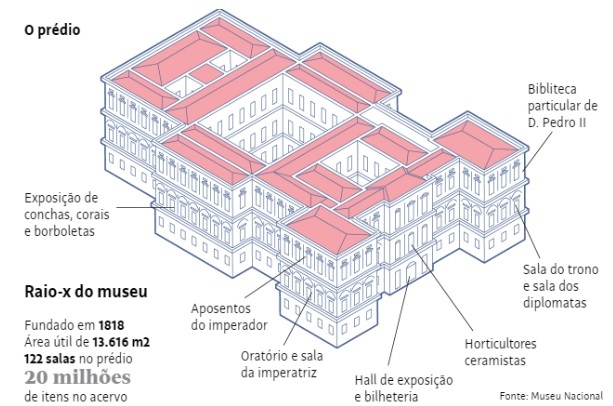
- “Luzia”, the oldest human fossil found in the country (12,000 years old) that was on display in the Biological Anthropology collection (original from Lagoa Santa, in Minas Gerais)
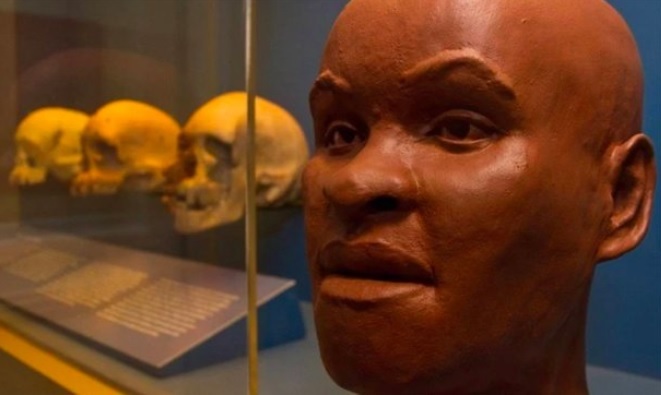
- Paleontology collections that included the Maxakalisaurus topai, dinosaur from Minas Gerais
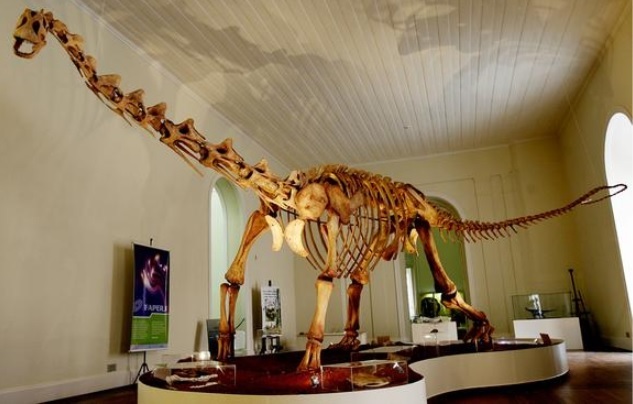
- Collection of Greco-Roman art and artifacts belonging to Empress Teresa Cristina
- Largest collection of Egyptian mummies in the Americas, with main pieces belonging to the collection acquired by Emperor Dom Pedro I (adults, children and animals)

- Tombstones with hieroglyphic inscriptions as part of the Egyptian collection
- Bendegó meteorite, the largest ever found in the country (original from Monte Santo, Bahia)
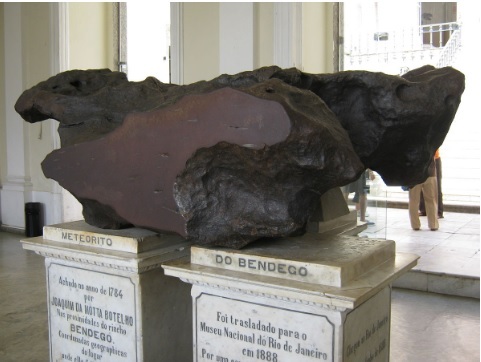
- Collections of Greek and Etruscan vases (people of Etruria, on the Italian peninsula)
- Exhibition of shells, corals and butterflies
- Private library of Dom Pedro II
- Royal and Imperial Family Rooms
- Mummified body of an Aymara Indian, a pre-Columbian group that lived near Lake Titicaca

- Coffin of Sha Amun en su, one of the 700 pieces in the Egyptian collection
- Throne of Dahomey (African king Adandozan), donated to Prince Dom João VI in 1811
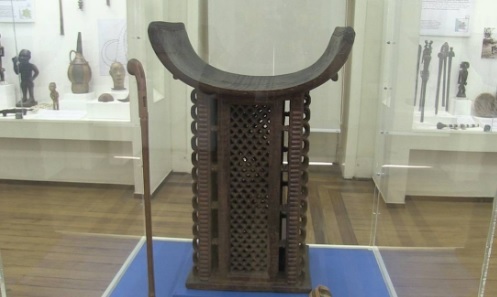
- Classic archeology collection consisting of 750 pieces
- Artifacts from Amerindian civilizations such as objects from the Tikuna people, items from Pacific cultures, 1,800 artifacts from the pre-Columbian era
Fortunately, the deputy director of the National Museum of Rio de Janeiro, Cristina Serejo, said that a collection of invertebrates managed to escape the great fire.
Financial problems
The National Museum of Rio de Janeiro is one of the institutions that suffered from the budget cut for culture and education. In an article published by Folha in May, it was informed that, since 2014, the museum has not received the full annual budget of R$520,000.
In the same article, it was stated that ten of the 30 exhibition rooms were closed to visits, including the one that held the skeleton of a humpback whale and Maxakalisaurus topai, the first large dinosaur ever mounted on the country. The room was closed off after a termite attack.
To reopen it, the museum organized a virtual crowdfunding with the goal of raising R$ 50,000. By June, the campaign had reached R$40,000. The lack of structure meant that less than 1% of the museum's collection was on display. The physical decadence of the institution became visible to visitors, in addition to the lack of technological resources in the exhibitions.
The lack of interactivity and the uninviting environment may be some of the causes for the drop in attendance since 2013. With tickets at BRL 8.00, the museum received less than 118 thousand visitors in 2016. The lack of money led UFRJ to close it temporarily, due to the lack of conditions to pay outsourced employees.
Not even the bicentennial celebrations of the museum escaped the lack of funds, so the 200th anniversary was celebrated with a small party. On that date, the institution also celebrated a BRL 21.7 million contract with the BNDES for its restoration. Another million dollar deal was on the way to fund a major exhibition.
Big fire in September
On the night of the 2nd of September, a large fire engulfed the three floors of the National Museum in Rio de Janeiro. A task force of 80 men and 21 trucks from the Fire Department was called in to fight the fire. Vehicles from Cedae (State Water and Sewage Company) and Comlurb (Municipal Urban Cleaning Company) helped transport water.
However, some aggravating factors hampered the action, including the lack of fire hydrants around the museum. Thus, the fight against the flames was carried out with the support of tank trucks and water from a lake located inside Quinta da Boa Vista. The general commander of the corporation pointed out that the problem delayed the work by about 40 minutes.
The fire started around 19:30 on Sunday and was only controlled at 02:00 on Monday (03). However, even at this moment, firefighters were working to contain small internal outbreaks, preventing a new fire from taking over the already destroyed building. Only a few parts and equipment were saved in time.
The building did not have any fire prevention system. The equipment would be installed thanks to the funds obtained from a contract signed with the National Bank for Economic and Social Development (BNDES) for the restoration of the museum. The BRL 21 million budget was signed during the institution's bicentennial celebrations.
The old structure of the building and what it contained may have contributed to the spread of the fire. Roberto Leher, rector of UFRJ, commented that the museum had laboratories, administrative and IT areas, structures that consumed a lot of energy.
And now, what will become of the National Museum?
The rector of UFRJ, Roberto Leher, and the general director of the National Museum, Alexander Kellner, still haven't managed to pass on the exact losses of the great fire. According to them, firefighters and employees managed to rescue part of the pieces before the fire spread. However, most of the more than 20 million items were destroyed.
“Certainly, many ethnographic collections, which are more vulnerable to fire, botanical, etc., were irretrievably lost”, lamented Kellner. The institution is linked to the university, which, like others in the country, suffers from frequent cuts in funding. Leher stressed UFRJ's lack of conditions to fund the museum's reconstruction works.
Kellner also demanded that the federal government be responsible for allocating resources to the works, claiming that “it would be cowardice for UFRJ to want it to solve all the problems, which come from a long way time". On Sunday night (02), the Ministry of Education released a note stating that it will spare no effort in restoring the museum.
